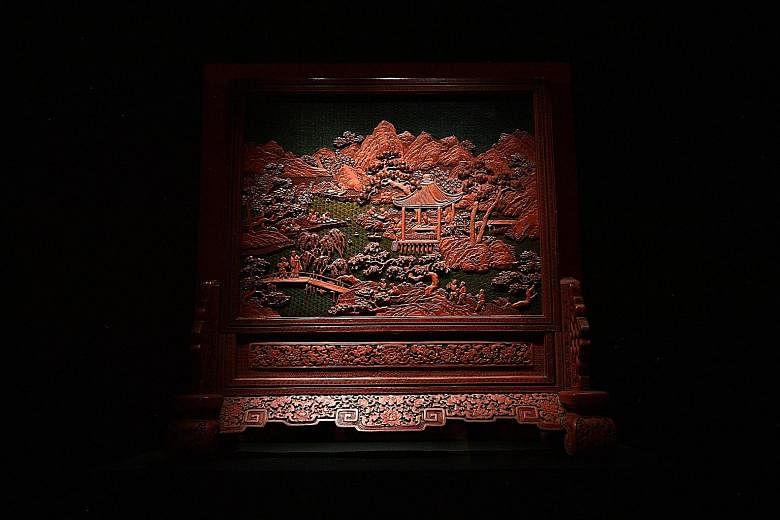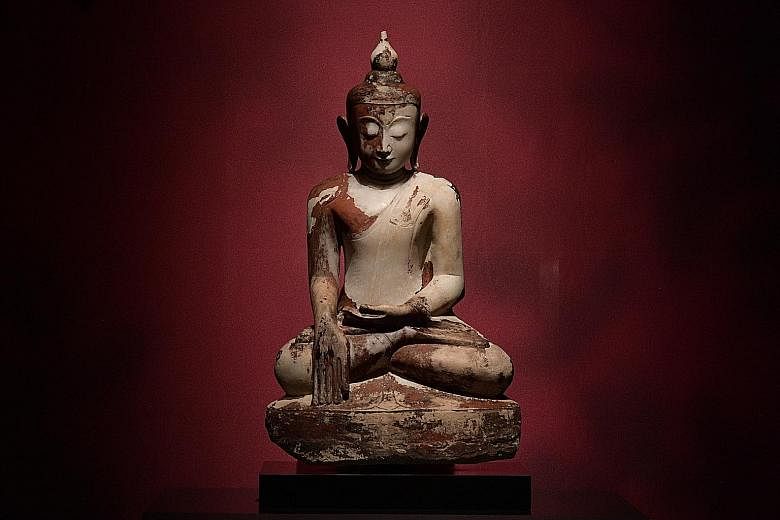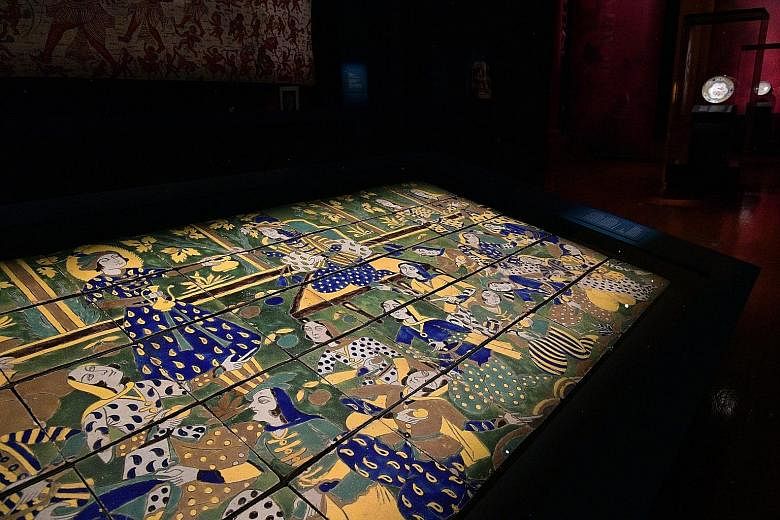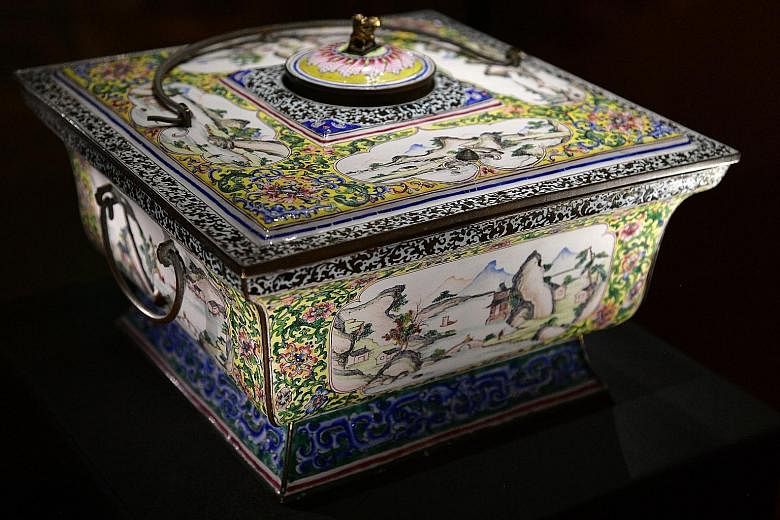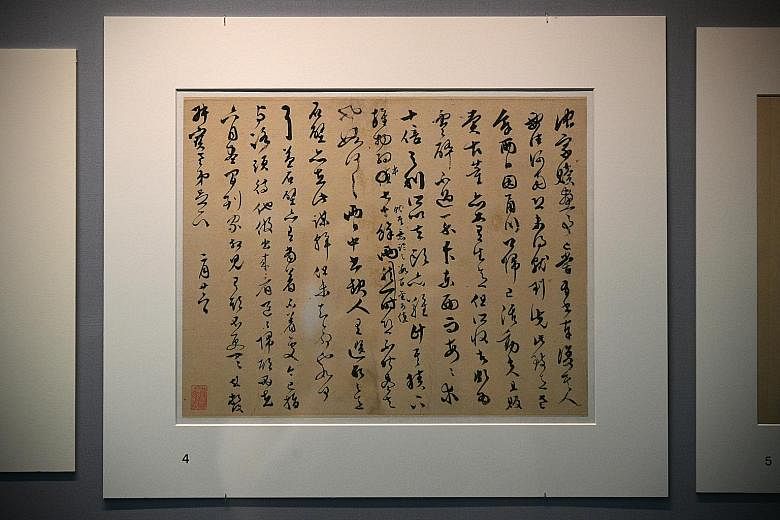Three new exhibits opened at the Asian Civilisations Museum (ACM) yesterday - with a personal twist.
Faith Beauty Love Hope - Our Stories, Your ACM showcases treasures from the ACM collection, cherry-picked not just by curators but other people working behind the scenes, including technical staff and student volunteers.
Aptly enough, the captions accompanying the items narrate the personal anecdotes behind the choices.
Another story is told at thINK, an exhibit about Hong Kong-based Dr Yuan Shao Liang, who has lent items from his family collection to ACM since the museum opened at the former Tao Nan School in 1997.
Last but not least, Singaporean artist Dawn Ng shares her personal take on memory in an installation titled Perfect Stranger.
The work, comprising 60 blocks of paper inscribed with text, grew out of a question-and-answer project with a stranger, Zehavit Efrati, an Israeli psychologist living in Singapore, in 2016.
ACM's director Kennie Ting, 42, says that the Faith Beauty Love Hope exhibition was put together because the museum's planned blockbuster, a collaboration with Beijing's Palace Museum centred on Ming Emperor Yongle, was cancelled due to the pandemic.
"Obviously we have been collectively going through quite a lot this year. But we felt we also need to acknowledge the fact that each and every one of us has gone through personal challenges."
Hence the title of the new show, which Mr Ting says resonates deeply with him as values which will sustain everyone through difficult times.
The show's guiding principle, allowing people involved in the museum to have a hand in choosing items, acknowledges the museum's role in a broader context.
Ms Kan Shuyi, 37, ACM's curator of Chinese art, says curators are usually the defining voice of exhibitions, but "the museum is a village in a larger community".
This show reflects that community by including staff members such as senior manager of technical display, exhibitions Mazlan Anuar, 62.
-
FAITH BEAUTY LOVE HOPE - OUR STORIES, YOUR ACM
WHERE: Asian Civilisations Museum, 1 Empress Place, Level 2 Special Exhibitions Gallery
WHEN: Till Feb 28, 10am to 7pm daily (10am to 9pm on Friday)
ADMISSION: $12 for Singaporean and permanent residents, free for children aged six and below, students and senior citizens; $20 for foreign visitors
INFO: www.nhb.gov.sg/acm
THINK: CHINESE CALLIGRAPHY, CONNOISSERSHIP, AND COLLECTING
WHERE: ACM, Level 1, Contemporary Gallery
WHEN: Till Apr 25
ADMISSION: Free for Singaporeans and permanent residents
-
PERFECT STRANGER
WHERE: ACM, Level 2, Shaw Foyer
WHEN: Till Feb 28
ADMISSION: Free for Singaporeans and permanent residents
His choice of an enamelled copper dish was motivated by its association with the late Madam Eng-Lee Seok Chee, whose family donated the item.
The veteran museum staff, who joined the National Museum of Singapore in 1982, worked with Madam Eng when she was a curator.
He recalls: "She was very soft-spoken. Thirty-seven years I've been working in museums and I am still practising what I learnt from her."
The collector's voice is highlighted in thINK, originally conceived as a companion show to the scuttled Ming dynasty show but now offering a counterpoint to Faith Beauty Love Hope.
Mr Bernard Tan, 42, guest curator of thINK, says: "We want to ask our audiences what we collect, whether it's tangible or intangible, whether it's memories or something which marries form and function."
The deputy director of retail and merchandising at the National Heritage Board notes that sometimes the tangible and intangible blur, as in the case of a set of stele rubbings commissioned by Dr Yuan's father.
"This is the only remaining archive of some of these cultural structures that were destroyed during the Cultural Revolution," he says.
Memories are also central to Singapore artist Dawn Ng's installation at the Shaw Foyer. The project began when she was pregnant with her daughter Ava in 2016.
"One thing that really hit me was the finiteness of time. Before having children, you always feel that time is infinite, and that you're forever young. With her coming into my life, what struck me was that though I would see to her beginning, she would most likely and surely see to my end."
The three exhibitions offer overlapping themes which Mr Ting hopes will end 2020 on an optimistic note. He says: "A museum is nothing without people. We want visitors to come and take away something, but also leave something behind on the digital wall."
The interactive social wall at the Faith exhibition offers visitors a chance to pick their favourite object and post it for others to see.
Ms Kan adds: "In a museum, where there are objects that are timeless and transcend geography and historical boundaries, it's a reminder that all things will pass."
Five highlights from Faith Beauty Love Hope And thINK
1 TABLE SCREEN: GATHERING OF SCHOLARS, CHINA
Mid-18th century, lacquered wood
Curator Kan Shuyi likens this screen to an "antique television". This is an opportunity to see both the front and back of the piece as it is displayed in a standalone vitrine.
The two sides depict different scenes and it is the side which shows a famous 4th-century literary party at the Orchid Pavilion that intrigues Ms Kan.
She says the romanticised portrayal is beguiling.
"To be away from the daily hustle and bustle and compose poetry, surrounded by friends, nature and the coolness of early spring, is a lovely escape."
2 SEATED BUDDHA, SHAN STATE OR BAGAN (MYANMAR)
18th century marble with traces of lacquer, paint and gold leaf
Ms Birte Koehler, senior conservator (objects) at the Heritage Conservation Centre, credits this item for inspiring her long exploration of the art of Asian lacquer.
She arrived in Singapore in 2012 to work at the centre and an ACM curator asked her to determine whether the brown traces on the statue were Asian lacquer or ordinary paint.
She discovered that the brown residue comprised some six to eight layers of lacquer, which piqued her curiosity about this ancient Asian craft.
She has since travelled through South-east Asia and Japan to find craftsmen who are still using this technique. "Whenever I see this Buddha sculpture, I remember how much I have learnt and broadened my horizos since I arrived in Singapore."
3 TILE PANEL, IRAN 18TH CENTURY (SAFAVID PERIOD)
Glazed fritware
This is the first time this new acquisition, which arrived in January, is on display. This architectural feature might have adorned a garden pavilion at one point. It depicts the fruit-cutting scene from the life of the prophet Yusuf (Joseph).
Ms Noorashikin Zulkifli, the museum's curator of Islamic art, says the "swooning women" in this piece caught her eye. Yusuf is shown as a youth in a blue coat with yellow boteh (almond-shaped) motifs, bringing to mind the musical Joseph And The Technicolour Dreamcoat.
"This is what fascinates me," says the curator, "how stories survive and become part of our shared culture."
4 HOTPOT, CHINA, QING DYNASTY, QIANLONG PERIOD (1736 TO 1795)
Painted enamel on copper
Trust hotelier and restaurateur Loh Lik Peng to zoom in on a food-related item.
This intricately decorated hotpot caught the ACM board chairman's attention a few years ago when it was displayed in the trade gallery. He says: "As a foodie and someone who appreciates beautiful things, it was just striking to me that someone would design and make something so exquisite for eating hotpot."
He observes that "a lot of painstaking work" must have gone into the making of this pot. "I can't help but think how decadent their society was by that point in the Qing dynasty.
"It's also highly impractical as a cooking implement, which tells me they must have had a highly stylised ritual around eating and perhaps a strong cultural link to food and eating."
5 WEN PENG'S LETTER TO QIANGU, CHINA, MING DYNASTY (1368 TO 1644)
Ink on paper
A series of five letters on display in thINK offer insights into what some famous personalities thought about social and political issues of their time.
Culture vultures will be amused by this letter, written by Wen Peng, a famous maker of seals whose father Wen Zheng Ming was one of the Four Masters of Ming painting. Addressed to Qian Gu, Wen Zheng Ming's disciple, it speaks of the flourishing art trade where a work could fetch up to 10 times its original price.
